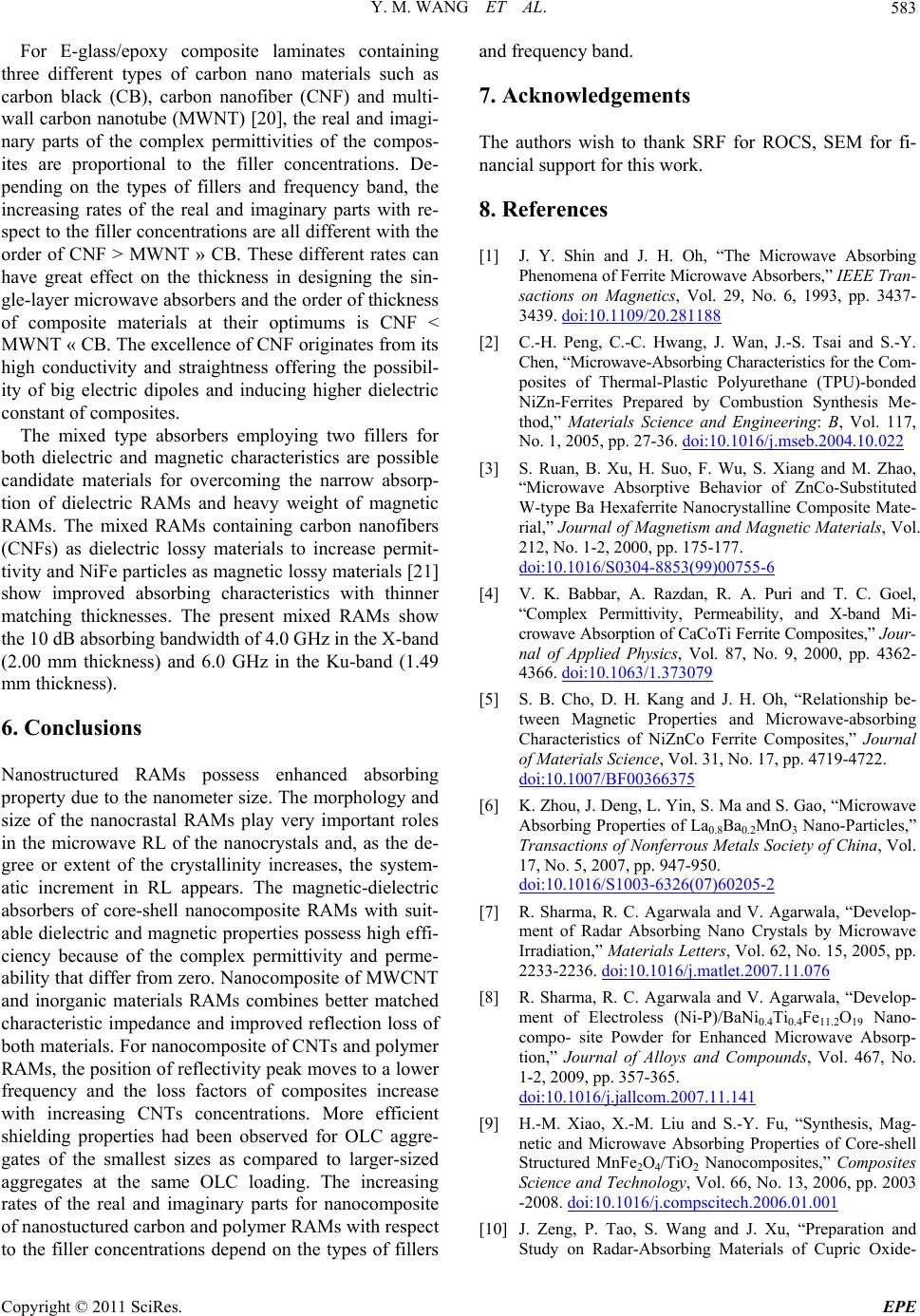
Y. M. WANG ET AL.583
For E-glass/epoxy composite laminates containing
three different types of carbon nano materials such as
carbon black (CB), carbon nanofiber (CNF) and multi-
wall carbon nanotube (MWNT) [20], the real and imagi-
nary parts of the complex permittivities of the compos-
ites are proportional to the filler concentrations. De-
pending on the types of fillers and frequency band, the
increasing rates of the real and imaginary parts with re-
spect to the filler concentrations are all different with the
order of CNF > MWNT » CB. These different rates can
have great effect on the thickness in designing the sin-
gle-layer microwave absorbers and the order of thickness
of composite materials at their optimums is CNF <
MWNT « CB. The excellence of CNF originates from its
high conductivity and straightness offering the possibil-
ity of big electric dipoles and inducing higher dielectric
constant of composites.
The mixed type absorbers employing two fillers for
both dielectric and magnetic characteristics are possible
candidate materials for overcoming the narrow absorp-
tion of dielectric RAMs and heavy weight of magnetic
RAMs. The mixed RAMs containing carbon nanofibers
(CNFs) as dielectric lossy materials to increase permit-
tivity and NiFe particles as magnetic lossy materials [21]
show improved absorbing characteristics with thinner
matching thicknesses. The present mixed RAMs show
the 10 dB absorbing bandwidth of 4.0 GHz in the X-band
(2.00 mm thickness) and 6.0 GHz in the Ku-band (1.49
mm thickness).
6. Conclusions
Nanostructured RAMs possess enhanced absorbing
property due to the nanometer size. The morphology and
size of the nanocrastal RAMs play very important roles
in the microwave RL of the nanocrystals and, as the de-
gree or extent of the crystallinity increases, the system-
atic increment in RL appears. The magnetic-dielectric
absorbers of core-shell nanocomposite RAMs with suit-
able dielectric and magnetic properties possess high effi-
ciency because of the complex permittivity and perme-
ability that differ from zero. Nanocomposite of MWCNT
and inorganic materials RAMs combines better matched
characteristic impedance and improved reflection loss of
both materials. For nanocomposite of CNTs and polymer
RAMs, the position of reflectivity peak moves to a lower
frequency and the loss factors of composites increase
with increasing CNTs concentrations. More efficient
shielding properties had been observed for OLC aggre-
gates of the smallest sizes as compared to larger-sized
aggregates at the same OLC loading. The increasing
rates of the real and imaginary parts for nanocomposite
of nanostuctured carbon and polymer RAMs with respect
to the filler concentrations depend on the types of fillers
and frequency band.
7. Acknowledgements
The authors wish to thank SRF for ROCS, SEM for fi-
nancial support for this work.
8. References
[1] J. Y. Shin and J. H. Oh, “The Microwave Absorbing
Phenomena of Ferrite Microwave Absorbers,” IEEE Tran-
sactions on Magnetics, Vol. 29, No. 6, 1993, pp. 3437-
3439. doi:10.1109/20.281188
[2] C.-H. Peng, C.-C. Hwang, J. Wan, J.-S. Tsai and S.-Y.
Chen, “Microwave-Absorbing Characteristics for the Com-
posites of Thermal-Plastic Polyurethane (TPU)-bonded
NiZn-Ferrites Prepared by Combustion Synthesis Me-
thod,” Materials Science and Engineering: B, Vol. 117,
No. 1, 2005, pp. 27-36. doi:10.1016/j.mseb.2004.10.022
[3] S. Ruan, B. Xu, H. Suo, F. Wu, S. Xiang and M. Zhao,
“Microwave Absorptive Behavior of ZnCo-Substituted
W-type Ba Hexaferrite Nanocrystalline Composite Mate-
rial,” Journal of Magnetism and Magnetic Materials, Vol.
212, No. 1-2, 2000, pp. 175-177.
doi:10.1016/S0304-8853(99)00755-6
[4] V. K. Babbar, A. Razdan, R. A. Puri and T. C. Goel,
“Complex Permittivity, Permeability, and X-band Mi-
crowave Absorption of CaCoTi Ferrite Composites,” Jour-
nal of Applied Physics, Vol. 87, No. 9, 2000, pp. 4362-
4366. doi:10.1063/1.373079
[5] S. B. Cho, D. H. Kang and J. H. Oh, “Relationship be-
tween Magnetic Properties and Microwave-absorbing
Characteristics of NiZnCo Ferrite Composites,” Journal
of Materials Science, Vol. 31, No. 17, pp. 4719-4722.
doi:10.1007/BF00366375
[6] K. Zhou, J. Deng, L. Yin, S. Ma and S. Gao, “Microwave
Absorbing Properties of La0.8Ba0.2MnO3 Nano-Particles,”
Transactions of Nonferrous Metals Society of China, Vol.
17, No. 5, 2007, pp. 947-950.
doi:10.1016/S1003-6326(07)60205-2
[7] R. Sharma, R. C. Agarwala and V. Agarwala, “Develop-
ment of Radar Absorbing Nano Crystals by Microwave
Irradiation,” Materials Letters, Vol. 62, No. 15, 2005, pp.
2233-2236. doi:10.1016/j.matlet.2007.11.076
[8] R. Sharma, R. C. Agarwala and V. Agarwala, “Develop-
ment of Electroless (Ni-P)/BaNi0.4Ti0.4Fe11.2O19 Nano-
compo- site Powder for Enhanced Microwave Absorp-
tion,” Journal of Alloys and Compounds, Vol. 467, No.
1-2, 2009, pp. 357-365.
doi:10.1016/j.jallcom.2007.11.141
[9] H.-M. Xiao, X.-M. Liu and S.-Y. Fu, “Synthesis, Mag-
netic and Microwave Absorbing Properties of Core-shell
Structured MnFe2O4/TiO2 Nanocomposites,” Composites
Science and Technology, Vol. 66, No. 13, 2006, pp. 2003
-2008. doi:10.1016/j.compscitech.2006.01.001
[10] J. Zeng, P. Tao, S. Wang and J. Xu, “Preparation and
Study on Radar-Absorbing Materials of Cupric Oxide-
Copyright © 2011 SciRes. EPE